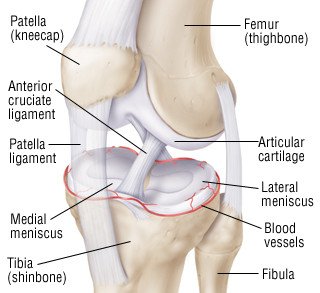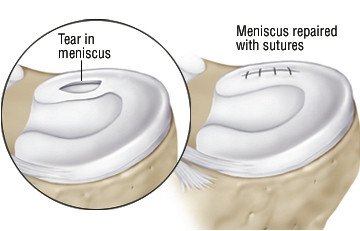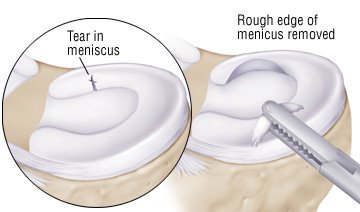Torn Meniscus
Medically reviewed by Drugs.com. Last updated on Jan 22, 2024.
What is a Torn Meniscus?

A meniscus is a disk-shaped piece of cartilage that acts as a shock absorber inside a joint. Each knee has one lateral meniscus under the outer knob of the thighbone and one medial meniscus under the inner knob of the thighbone. Each meniscus acts as a natural cushion between the thighbone (femur) and shinbone (tibia). The two cushions prevent excess wear and tear inside the knee joint by keeping the ends of the two bones from rubbing together. Each meniscus also absorbs much of the shock of jumps and landings and helps to distribute joint fluid evenly to lubricate and nourish the knee.
|
|
In the United States, a torn meniscus is the most common reason for knee surgery.
Symptoms
The symptoms of a torn meniscus can include:
- Knee pain, usually on one side of your knee
- Tenderness at the side of the joint
- Knee swelling within the first 12 hours after injury
- A "locked" knee that can't be bent
- A knee that catches during movement, or can't be fully straightened
- A click, pop or grinding inside your knee when you move it
- A knee that buckles, gives way or feels generally weak
Diagnosis
Your doctor will inspect both your knees to compare your injured knee with your uninjured one. He or she will check your injured knee for signs of swelling, tenderness and fluid inside the knee joint. If your knee is not locked, the doctor will bend your injured knee and check for clicks, snaps and "catches" within the joint. Your doctor also will evaluate your knee's range of motion and will maneuver your knee to see whether your meniscus is sensitive to pressure. For example, in the "McMurray test," the doctor bends the leg at the knee, and then rotates it inward or outward while straightening it. If you feel pain during this test or if there is a "click" sound as your leg rotates, there is a good chance that your meniscus is torn.
If the results of your exam suggest you have a torn meniscus, you may need more tests, including:
- Knee X-rays to check for bone injuries, including fracture, that can cause symptoms similar to a torn meniscus
- A magnetic resonance imaging (MRI) scan or computed tomography (CT) scan — Nine out of 10 times, a torn meniscus will show up on one of these tests. However, it is important to keep in mind that some meniscal tears detected by MRI – especially small ones – cause no symptoms and require no treatment.
- Arthroscopy (camera-guided surgery) to look inside the knee joint and examine the meniscus — When arthroscopy is used for diagnosis, the problem can often be treated during the same surgery.
Expected Duration
If you have arthroscopic surgery to treat your torn meniscus and your job involves sedentary work (mostly sitting), you may be able to return to work one to two weeks after surgery, with full recovery in about four to eight weeks. If you are an athlete or your job requires a lot of physical activity, it may take three to four months after surgery before you feel like you have as much function in your knee as you require.
Prevention
Although it's hard to prevent accidental knee injuries, you may be able to reduce your risks by:
- Warming up and stretching before participating in athletic activities
- Exercising to strengthen the muscles around your knee
- Avoiding sudden increases in the intensity of your training program
- Wearing comfortable, supportive shoes that fit your feet and your sport
- Wearing appropriate protective gear during activities, including athletic activities, in which knee injuries are common (especially if you've had knee injuries before).
Treatment
There are several options for treating a torn meniscus:
- Nonsurgical — This may include a temporary knee brace and rehabilitation to keep the knee muscles strong while the knee is not bearing as much weight. This approach is most effective for small tears (5 millimeters or less) near the edge of the meniscus, where healing is usually good, or for people who are not good candidates for surgery.
- Surgery to repair the tear — If the tear is large (1 to 2 centimeters), but it involves part of the meniscus where there is enough blood supply for healing, the doctor may be able to repair it with stitches.
|
|
- Surgery to remove part of the meniscus (partial meniscectomy) — If the tear involves part of the meniscus where healing is poor, the surgeon may trim away ragged edges along the tear to allow the joint to move smoothly.
|
|
- Surgery to remove the entire meniscus (total meniscectomy) — This option is used for tears that cannot be treated any other way. Doctors try to avoid this, because it leaves the knee without a meniscus and greatly increases the wear on the ends of the femur and tibia. In the long run, this also increases the risk of osteoarthritis (degenerative joint disease) in the knee.
If you need surgery to correct a torn meniscus, it usually can be done using arthroscopy (camera-guided surgery) as a same-day procedure. After the procedure, you will begin physical therapy to help strengthen your knee muscles, reduce pain and swelling, and return the knee's full range of motion.
When To Call A Professional
Call your doctor to schedule an evaluation whenever an injured knee:
- Locks, catches or can't be fully extended
- Becomes very painful or swollen
- Makes a click, pop or grinding sound when you move it, especially if associated with pain
- Buckles, gives way or feels generally weak
Prognosis
In most cases, the outlook is very good. If your torn meniscus has been repaired surgically or partially removed, you probably will be able to resume your normal athletic activities once you've finished physical therapy.
According to long-term studies, most people who have had a meniscus repaired feel very satisfied with the results of their surgery, even 10 or 11 years after the procedure. However, some people with meniscus injuries eventually develop arthritis in the injured knee. Typically, arthritis develops many years after the injury. The highest risk is among those who've had a part or all of the meniscus removed, because significant injuries requiring this surgery often damage the joint but also because these surgeries take away some or all of the cushioning effect of the meniscus.
Additional Info
National Institute of Arthritis and Musculoskeletal and Skin Diseases
http://www.niams.nih.gov/
National Rehabilitation Information Center (NARIC)
http://www.naric.com/
American Orthopedic Society for Sports Medicine
http://www.sportsmed.org/
National Athletic Trainers' Association
http://www.nata.org/
American Physical Therapy Association
http://www.apta.org/
Further information
Always consult your healthcare provider to ensure the information displayed on this page applies to your personal circumstances.



